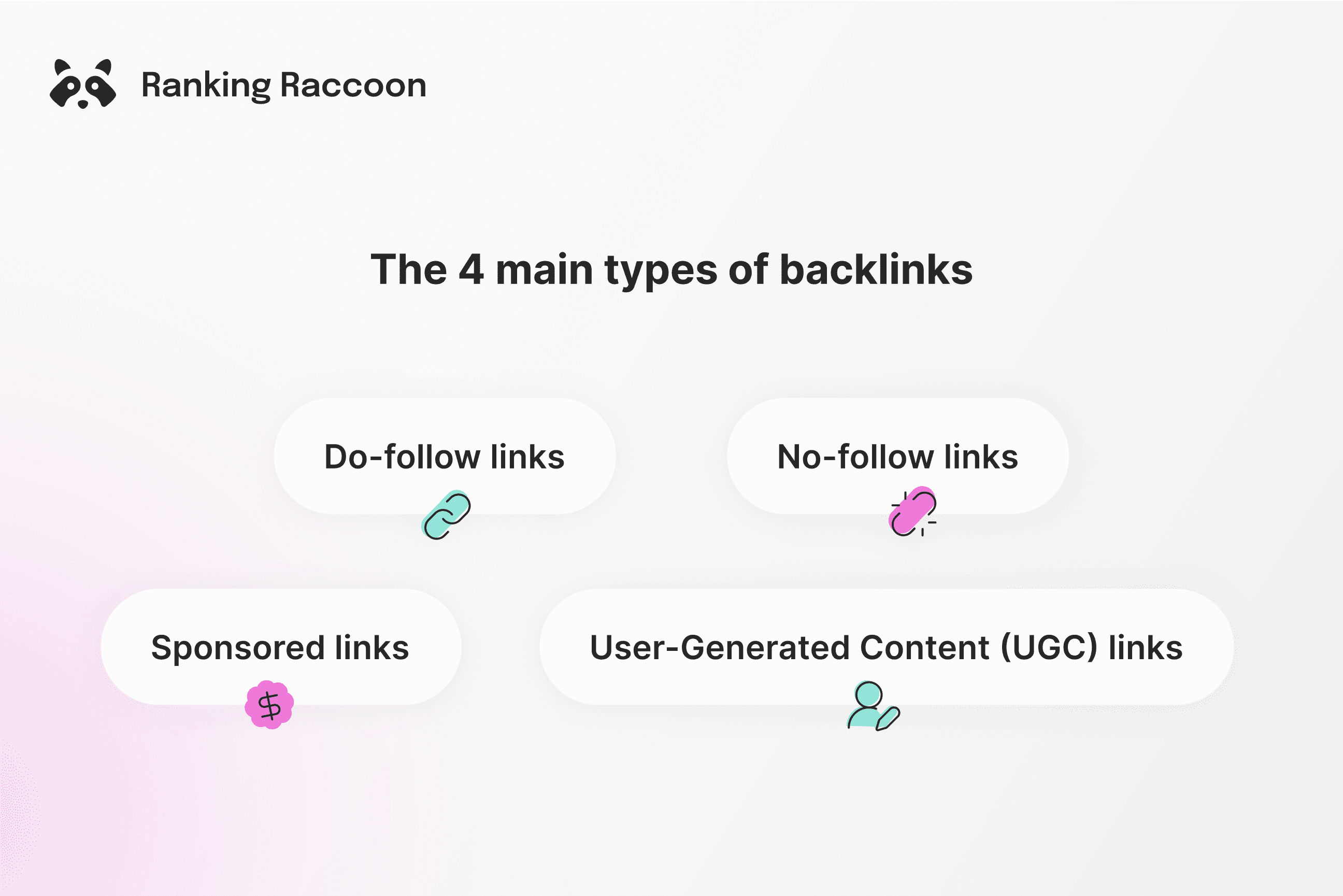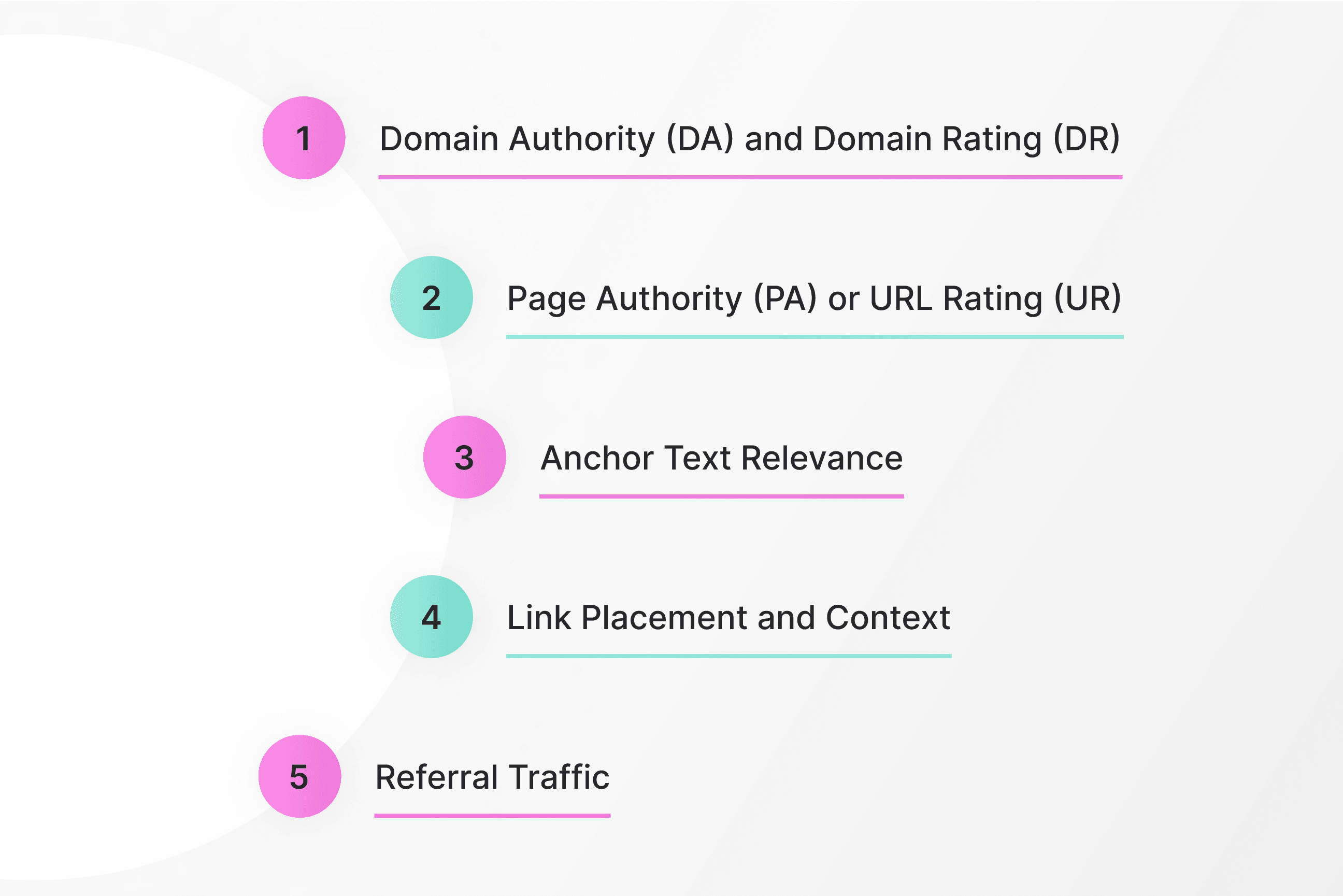5 Link-Building Metrics You Got to Track in 2025

Natalia Toth
What are link-building metrics?
Link-building metrics are the key performance indicators (KPIs) for your link-building efforts. They’re the data points that give you insight into how effective your backlinks are. Are they driving traffic? Boosting your rankings? Or are they just sitting idle, not doing much of anything? With the help of these metrics, you can figure that out and come up with the next steps in your SEO strategy.
Link-building metrics help in understanding the quality, relevance, and impact of the links pointing to your site. The better you understand these metrics, the more strategic you can be in building links that actually help your SEO.
Why link-building metrics matter
Backlinks act like votes of confidence and credibility for your site. When a reputable site links to yours, it’s like they’re saying, “Hey, this content is legit and provides value!”.
And Google? Well, Google listens. The more high-quality backlinks you have, the better your chances of climbing the search rankings and driving organic traffic.
But just building links isn’t enough. You need to measure them, track them, and understand what’s moving the needle.
Link-building metrics tell you whether your strategy is on point or if you’re just shooting in the dark. They help you analyze your domain's strengths that you can double down on, as well as the gaps you have yet to fill. Additionally, they help you understand your position within the competitive landscape.
The 4 main types of backlinks
Not all backlinks are equal.
Some are more powerful than others, and understanding how to spot the difference is crucial. That’s where link-building metrics come into play. They help you determine which backlinks are worth their weight in gold and which ones are providing little to no value.
But, before diving into link-building metrics, let's recap the basics of backlinks.
Here’s a quick rundown of the types of backlinks you’ll encounter:

- Do-follow links: These are the gold standard. They tell search engines that the link is an endorsement of the quality or relevance of that content. As a consequence, they pass on what's called "SEO juice" to your site, helping boost your rankings.
- No-follow links: These links contain a "nofollow" attribute, which tells search engines to not pass SEO value, but they’re still useful for driving traffic and diversifying your link profile, as well as enhancing brand visibility.
- Sponsored links: These are paid advertisements that appear on search engine results alongside organic search results, or simply "Ads". They might not pass SEO value, but they can still boost your visibility and increase brand awareness.
- UGC links: User-generated content backlinks (think comments or forum posts) are normally no-follow, but they add a healthy variety to your backlink profile. Monitor UGC links to make sure they're relevant and not spammy.
Just like these types of backlinks are different from each other, they also contribute to your overall SEO strategy in different ways, and metrics help you assess their influence on your backlink profile.
5 key link-building metrics you should track
Now that we’ve covered the basics, let’s get into the good stuff: the metrics you need to track to ensure your link-building efforts are paying off.
Let’s take a deeper dive into some of the most important link-building metrics. Understanding these will not only sharpen your SEO strategy but also help you make better-informed decisions when it comes to building and evaluating backlinks.

Domain Authority (DA) or Domain Rating (DR)
What they are
Domain Authority (DA) and Domain Rating (DR) are metrics developed by Moz and Ahrefs, respectively.
The goal of both is to measure the overall strength and credibility of an entire website's backlink profile. They serve as a parameter to predict how likely a website is to rank on search engine results. DA ranges from 1-100, while DR is between 0-100. The higher the score, the stronger the domain is. Websites that have higher DA or DR tend to rank better in search engines.
But how different are DA and DR from each other?
Well, Moz's DA takes into account the quantity, quality, and relevance of links pointing to a domain in a more holistic way, while Ahrefs' DR focuses more on the quality of backlinks and how many unique domains are linking to a site. DA could be your go-to metric if your goal is to predict overall SEO performance while DR could be used for a more thorough evaluation of your backlink profile.
You should keep in mind, though, that these metrics can't be looked at in isolation. They won't be your magic key to top rankings, because a bunch of other factors also play a role in SEO performance, like content quality and user experience, for example.
Why they matter
High DA/DR sites are like the heavyweights in the SEO world. Links from these sites are considered more authoritative and pass more "link juice", which can significantly boost your own site’s rankings.
Think of it this way: if a well-established news outlet or a leading industry blog links to your content, Google interprets it as a strong endorsement of your site's quality. This is because a high DA/DR suggests that a site is trusted by other sites, and Google rewards that trust with higher search rankings.
Moreover, DA/DR isn’t just about the number of backlinks. The highlight goes to the quality of those links. A link from a DR 80 site is generally going to have a more positive impact on your rankings than a dozen links from DR 10 sites.
So, when prospecting for backlinks, aim for high DA/DR domains to maximize SEO benefits, while also considering the relevance of your links for their content.
Page Authority (PA) or URL Rating (UR)
What they are
Page Authority (PA) and URL Rating (UR) are similar to DA/DR, but instead of evaluating an entire domain, they focus on the strength of individual pages or URLs. PA is a metric from Moz, while UR was created by Ahrefs. Both measure, on 0 or 1-100 logarithmic scales, how well a specific page is likely to rank on search engine results pages (SERPs).
These metrics consider factors like the quality and quantity of links pointing to the specific page, the relevance of those links, and the quality of the page's content itself.
Why they matter
Targeting pages with high PA/UR for backlinks can be a game-changer.
Why? Because these pages already have strong link equity. When they link to your page, they pass on some of that equity, potentially giving your page a substantial boost in rankings.
High PA/UR pages are typically well-optimized and receive a lot of traffic, meaning that a backlink from such a page is more likely to drive direct traffic to your site as well. This is especially important if you're trying to rank for competitive keywords.
In essence, a backlink from a high-PA/UR page is like getting an endorsement from an expert in the field — it carries more weight and can help you leapfrog competitors in search results.
PA and UR can also be useful for benchmarking competitors and auditing your site to identify its stronger pages, as well as those that need further work. You can also track them to check the impact of your efforts over time.
Anchor Text Relevance
What it is
Anchor text is the clickable text in a hyperlink, usually underlined and in a different color to distinguish it from regular text. It provides context about the content of the linked page, helping users understand what to expect when clicking the link. It indicates the relevance of the linked page to specific keywords, making it a crucial factor in link building and SEO.
For example, if you’re trying to rank for “best running shoes”, having a backlink with the anchor text “best running shoes” is highly relevant and beneficial.
There are multiple types of anchor text:
- exact-match (when it equally matches targeted keywords)
- partial-match (when it includes variations of the target keyword, like "great running shoes" instead of "best running shoes")
- branded (when a brand's name is the anchor text)
- naked link (the URL itself is the anchor text), and
- generic (like "click here").
Why it matters
Google uses anchor text as a major ranking signal.
When the anchor text of backlinks aligns closely with the keywords you’re targeting, it signals that your page is relevant to those keywords.
Also, if multiple sites link to your page using the same keyword-rich anchor text, it means that your page is very likely a valuable resource for that topic. This is why optimized anchor texts make a difference in your rankings.
However, there’s a balance to be struck.
Over-optimization of anchor text (i.e. too many exact-match anchors) can raise red flags for Google and might result in penalties.
Instead, a mix of exact-match, partial-match, and branded anchor texts, for example, creates a more natural and effective backlink profile. Relevance is key, but so is variety.
Link Placement and Context
What it is
This metric evaluates where your backlink is placed on a page, as well as the context surrounding it. A link can appear in different places, such as the content body, sidebar, footer, or even within a comment section.
As for the context surrounding it, a backlink embedded within a relevant, well-written paragraph is more valuable than one that’s awkwardly added to a list of random links at the bottom of the page.
Why it matters
Links placed naturally within the main content, especially early in the article or toward the top of the page, carry more SEO weight. This is because Google’s algorithms value links that are likely to be clicked by readers. A link placed within the first few paragraphs of a relevant article is more likely to be clicked, making it more valuable.
On the other hand, links added into footers, sidebars, or unrelated content are often ignored by readers—and by Google. These placements can diminish the value of the link and might even be seen as an attempt to manipulate rankings. The more natural and contextual the link placement, the better it is for your SEO.
You can also take this into account when crafting content: evaluate existing articles on the same topic and think about what additional valuable insights you can provide that would increase your chances of getting links in top placements of related articles.
Referral Traffic
What it is
Referral traffic is the amount of traffic that comes to your website via a backlink from another site, rather than through search engines or direct visits.
When someone clicks on a link pointing to your site from another domain, it’s recorded as referral traffic in your analytics. It can include affiliate links, content partners, social media and media coverage.
Why it matters
Referral traffic is a direct measure of a backlink’s effectiveness. High referral traffic indicates not only that the backlink is placed on a well-trafficked page, but also that it's relevant and engaging enough to prompt users to click through.
High-quality backlinks often lead to higher referral traffic, which is a good sign of credibility and relevance. This can also help with other SEO metrics, like reducing bounce rates and increasing the average time spent on your site, both of which are positive authority signals to search engines.
Referral links usually bring high-quality visitors who are more likely to engage with your content and become customers, which is a benefit that goes even beyond SEO. Moreover, they can also impact your brand awareness and networking opportunities.
If you have hard times measuring the effect of your link-building campaigns, check out our 5-step guide on how to access link-building ROI in GA4.
Boost your metrics by keeping it relevant
Now that you learned about the top link-building metrics, you can assess the potential value that a link can add to your site with their help. On top of that, you might have noticed that a common theme emerging from what influences metrics is relevance.
To boost your link-building metrics and, ultimately, your rankings, check if you can answer these 4 questions:
- What's the purpose of your site and who is it for?
You need to have a clear understanding of what you want to achieve with your site and the content you're publishing and stay focused. If you have an educational site, for example, focus on crafting your content based on the needs of your audience (in this case, students), and try to answer their most common questions.
- Does the other site's content align with your content's niche and topic?
You should also reflect on how much the potential linking site or page aligns with your own. If a site has extremely high DA/DR, but talks about a completely unrelated topic than yours, likely it won't help much. So, aim for sites in the same niche as yours. Is the primary topic of the page directly related to your page? Does your page add any contextual value to theirs?
- Are you both targeting the same audience?
Think about what are the visitors that the site or page is attracting. Which users' questions are they trying to answer? Are their users likely to be interested in your site too? Remember that a high-quality link brings in people who are likely to engage with your content and potentially turn into customers. How likely is this to happen with the site or page you're considering?
- What is the geographical relevance?
Especially if you're a local business, geographical relevance also matters. Let's say you own a local US e-commerce site. How much sense does it make to place a link on a local Colombian site? Aim for local links first for higher relevance.
Read more: 10 SaaS Sites That Got Link-Building Right
To sum it up
There you have it — an objective breakdown of the most important link-building metrics you need to keep an eye on, and how to boost yours.
Our advice: always prioritize relevance for long-lasting positive impacts on your metrics. It’s not just about getting links; it’s about getting the right, high-quality links placed correctly in relevant sites and pages, containing purposeful anchor texts.
Thankfully, there are awesome link-building tools like Ranking Raccoon that can help you get strong, impactful backlinks faster. You can get AI-driven recommendations of the best backlink partners, find pages with your target keywords in seconds, and send a link exchange proposal right away.
By focusing on quality over quantity and using these 5 metrics to guide your strategy, you’ll be well on your way to climbing those search rankings and getting the organic traffic you’ve been dreaming of. Happy linking!

Natalia Toth
Marketing Manager